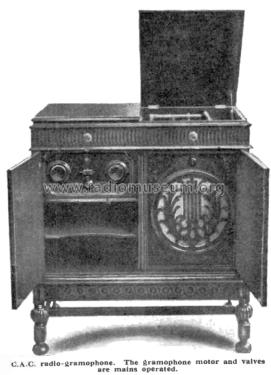C.A.C. Radiogramophone
CAC (C.A.C.) City Accumulator Co. (Radio Ltd. Valve/Cabinets); London
- Country
- Great Britain (UK)
- Manufacturer / Brand
- CAC (C.A.C.) City Accumulator Co. (Radio Ltd. Valve/Cabinets); London
- Year
- 1929
- Category
- Broadcast Receiver - or past WW2 Tuner
- Radiomuseum.org ID
- 346867
-
- Brand: CAC
- Number of Tubes
- 5
- Valves / Tubes
- Main principle
- TRF with regeneration
- Wave bands
- Broadcast only (MW).
- Details
- Record Player (not changer)
- Power type and voltage
- Line / Batteries (any type)
- Loudspeaker
- -Loudspeaker incorporated, but system not known.
- Material
- Wooden case
- from Radiomuseum.org
- Model: C.A.C. Radiogramophone - CAC C.A.C. City Accumulator Co
- Shape
- Console, Lowboy (legs < 50 %).
- Notes
-
The £75 model illustrated incorporates a B.T.H. pick-up and a G.E.C. universal (D.C. or A.C.) motor and an automatic device that cuts out the motor and breaks the valve current when the record has been played.
A pilot light gives a warning when the motor is running and also serves, as a series resistance to reduce the mains voltage. A ½ megohm variable resistance (volume control) shunts the pickup output, which is fed to four Cosmos A.C. valves.
Batteries (except grid bias) are replaced by a Cosmos eliminator, and a choke-filter unit feeds the final output to an " Ultra " balanced armature with folded exponential horn loudspeaker.
For radio, five valves are employed, the first, a H.F. valve, is the new indirectly heated screen-grid valve (AC/S) which is carefully screened in a copper box. The three L.F. valves are coupled by the " C.A.C. coupler," which consists of 47-gauge Eureka wire-wound transformers without any iron core.
The coupling between primary and secondary is tight so there is probably considerable capacity between these windings.
No attempt to explain this unorthodox amplifier can be made here, but suffice it to say that very considerable volume is available and that the high notes do not appear to be missing, as might be the case if a conventional multi-stage resistance amplifier were employed.
An indoor or outdoor aerial is required for radio, whilst for tuning there are two controls, together with a capacity control of reaction
- Price in first year of sale
- 75.00 GB £
- Mentioned in
- Wireless World (The), London (WW, 79) (Mar 6, 1929, Page 241.)
- Author
- Model page created by Gary Cowans. See "Data change" for further contributors.
- Other Models
-
Here you find 10 models, 9 with images and 1 with schematics for wireless sets etc. In French: TSF for Télégraphie sans fil.
All listed radios etc. from CAC (C.A.C.) City Accumulator Co. (Radio Ltd. Valve/Cabinets); London
